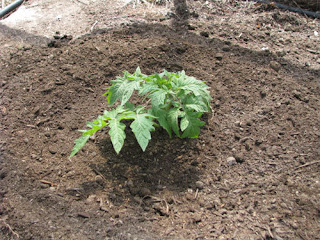 |
| Black Russian |
Not that I'm an expert but this is a rough guide to how i grow my tomatoes and what i have found to work. i would really like to open a discussion and post the various suggestions or questions.
Tomatoes need warm soil and warm weather to thrive and ward off diseases. It seems to me that every year Bunning’s and other big garden suppliers sell their tomatoes sooner and sooner, knowing full well that the customer will probably be back for more. Depending on how the season is I don’t plant my tomatoes in the ground until after Melbourne cup, and well after if we are having a frosty spring.
 |
| Tigerella & Tatura Dwarf |
Many times you can put in a tomato plant a good month after your too-early one, and find the later-planted seedling quickly catching up and surpassing the other deprived, stunted one you nursed along during a too-cold spring. Another good time to plant your second successive crop is on Boxing Day or when first lot flowers.
Tomatoes need good nutrition. To get big fat healthy tomatoes, First dig a deep hole and at the bottom of that add a fish head. This adds both nitrogen and calcium as it decomposes over time. I then add two or three crushed chicken eggshells; The value of eggshells is that it's a cheap, organic method of adding calcium to your soil. Sulphate of potash is next which is high in phosphorus, which aids in both root formation and blossom production. The more flowers you get, the more fruit you get, and it adds to the flavour.
I also put two handfuls of a good dry, all-purpose organic fertilizer in the bottom of the hole. "All-purpose" means that all three macro nutrients are represented in similar quantities. The macro nutrients are nitrogen, phosphorus and potassium, making sure it is organically approved and not just called organic approved. Check here or here
A tablespoon of worm castings goes in and two regular aspirin tablets a few inches into the soil about 6 or so inches away from your planted tomato seedling. Aspirin contains salicylic acid, which has been shown to boost the immune system of tomatoes, making them more disease resistant.
Tomato plants want to be planted deep, so get at least two thirds of that stem under the ground. This is because all of those tiny fuzzy hairs sticking out of the stem turn into roots once buried. The more roots there are, the better able the plant is able to uptake more nutrients. You can either dig a deep hole, or use the “trench” method, which works particularly well with long seedlings. Dig a narrow trench, about four or five inches deep, then lay the plant in sideways, bending the top up and out of the end of the trench. Make sure you water all along the length of the trench for a while, in order to get the root ball wet.

Tomatoes don't like to be crowded. Tomato plants also need a free flow of air around them to keep down foliar diseases, and crowding them will inhibit airflow around 90cm apart. allow them to grow up naturally using good vertical and horizontal supports. i use 2mt high cylindrical cages. Simply cut lengths of large square chicken wire or weld mesh , attach them into a cylinder using either narrow gauge wire, or bend back and twist the cut ends together to secure. These cylindrical cages can then be placed over your plant (one per cage). Drive a star picket or bamboo well into the ground next to the cage, and then tie the cage to the picket at several intervals. As the tomato plant starts to grow out of the cage, gently push back the growing tips inside the cylinder, training the plant to grow up inside the cage.
Feeding your tomatoes Use an organic fertiliserer every three weeks (every week if growing in a pot). I particularly like using worm casting tea. It's simple to make: throw a handful of pure worm castings and some comfrey leaves into a 20lt bucket of water.(dairy bucket) Let "steep" for two -three days.To use get yourself a 7.5lt sprayer add one and a half regular aspirin in the bottom of diluted worm casting tea dilute it up to four times with water then strain through cheesecloth. Spray this elixir once a week, but at least once every two weeks on the leaves in the morning. It tends to settle to the bottom of the bucket, so stir it up before watering.
Don’t over or Under Water .Most people water their tomatoes too much. It makes for watery tasting tomatoes, more diseases, and less fruit. The only time that a tomato needs to be watered every day, is if it's in a pot and the weather is consistently in the high 30's and in direct sun.You should observe your plants every day and see how they are doing with moisture. If the ground is wet, they don't need watering again for a while. If the plant is wilting, it may not be water deprived; it just may be hot for a few hours in high heat and will perk back up in the cool of the evening. Also some diseases cause the plant to wilt, and no amount of watering will cure that.


No comments:
Post a Comment